You will be met on arrival at the International airport. Transfer to your hotel. Relax.
DELHI, the capital of kingdoms and empires is now a sprawling metropolis with a fascinating blend of the past and the present. Delhi is a perfect introduction to the composite culture of an ancient land and a window to the kaleidoscope - that is India.
Overnight will be at Delhi.
After breakfast proceed for a day sightseeing tour of the city.
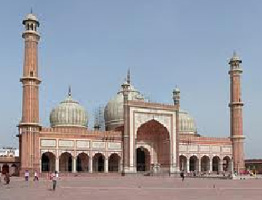 Start with the sightseeing of Old Delhi. The tour will begin with a visit to Raj Ghat, a simple memorial to Mahatma Gandhi; drive past the Red Fort continuing to the Jama Masjid by bicycle rickshaws, one of Asia’s largest mosques. The magnificent Red Fort, overlooking the river Jamuna was built during the years 1638 - 48 when the Moghul Empire was at its peak. The tour continues to Jama Masjid, one of Asia’s largest mosques and which is viewed from the outside.
Start with the sightseeing of Old Delhi. The tour will begin with a visit to Raj Ghat, a simple memorial to Mahatma Gandhi; drive past the Red Fort continuing to the Jama Masjid by bicycle rickshaws, one of Asia’s largest mosques. The magnificent Red Fort, overlooking the river Jamuna was built during the years 1638 - 48 when the Moghul Empire was at its peak. The tour continues to Jama Masjid, one of Asia’s largest mosques and which is viewed from the outside.
People stream in and out of the mosque continuously and the presence of a nearby bazaar means that the area is rarely quiet.
Enjoy the rickshaw ride at Old Delhi.
After visiting Old Delhi, you will be driven to New Delhi, which reflects the legacy the British left behind. The division between New and Old Delhi is the division between the capitals of the British and the Mughals respectively. The division in the walled city and New Delhi also marks the division in the life-styles. The walled city is all tradition where one will be able to glean a past life-style in all its facets, colours and spells. New Delhi in contrast, is a city trying to live up to the best of 21st century standards.
Imperial Delhi will include the Qutub Minar, the tallest stone tower in India. The tour also includes a drive past the imposing India Gate, the Parliament building and the Rastrapathi Bhawan, the President’s residence.
Overnight will be in Delhi.
Breakfast will be at hotel.
Transfer in time to airport for flight to Varanasi. Upon arrival at Varanasi, you will be met and transferred to hotel.
Picturesquely situated on the crescent shaped left bank of the holy River Ganges, Varanasi, one of the ancient seats of learning in India, is said to be a compound of the names of two streams, the Varuna and the Assi, which still flow in the north and south of the city respectively. This name seems to have been corrupted, in medieval times to Varanasi, which was in use till May 1956, when it was changed to Varanasi, by an order of the Government of India. Varanasi is probably one of the most ancient living cities in India. From time immemorial it has been a great religious center for Hindus and one of their most sacred places of pilgrimage, being visited by millions of people every year. To every visitor Varanasi offers a breathtaking experience. The rays of the dawn shimmering across the Ganges; the high-banks; the temples and shrines along the banks bathed in a golden hue …soul stirring hymns and mantras along with the fragrance of incense filling the air…and the refreshing dip in the holy waters gently splashing at the Ghats. Varanasi – The land where experience and discovery reach the ultimate bliss. Varanasi is also renowned for its rich tapestry of music, arts, crafts and education. Some of the world – renowned exponents India has produced in these fields were schooled in Varanasi’s cultural ethos. Luminaries apart, Varanasi abounds in the art of silk weaving, an exotic work of art which manifests itself in precious Banarasi silk sarees and silk brocades which are cherished as collector’s items across the world today.
 Visit Sarnath 5 miles out of Varanasi: The great Buddha enhanced the sanctity of Varanasi by choosing the environs of the city to preach his first sermon at Sarnath, (only 10 Kms away) after attaining enlightenment. Later, Ashoka, the great Mauryan Emperor erected magnificent stupas and other buildings along with his mighty stone pillar, Dharmarajika Stupa. The 110 ft. tall Damekh Stupa marks the place where Buddha preached first sermon.Sarnath has been a premier centre for Buddhism. It is a rich collection of ancient Buddhist relics and antiques comprising numerous Buddha and Bodhisatva images on display at the Archaeological Museum (1000 hrs to 1700 hrs. Open all days except Friday)
Visit Sarnath 5 miles out of Varanasi: The great Buddha enhanced the sanctity of Varanasi by choosing the environs of the city to preach his first sermon at Sarnath, (only 10 Kms away) after attaining enlightenment. Later, Ashoka, the great Mauryan Emperor erected magnificent stupas and other buildings along with his mighty stone pillar, Dharmarajika Stupa. The 110 ft. tall Damekh Stupa marks the place where Buddha preached first sermon.Sarnath has been a premier centre for Buddhism. It is a rich collection of ancient Buddhist relics and antiques comprising numerous Buddha and Bodhisatva images on display at the Archaeological Museum (1000 hrs to 1700 hrs. Open all days except Friday)
Enjoy the evening AARTI at the GHATS. The guide will be giving a commentary to you on the proceedings and meanings of the chants during the AARTI of the river.
Overnight will be spent at Varanasi.
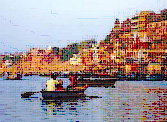 In the early morning drive to Daswamedh Ghat and take a boat ride on the sacred river Ganges to see the cremation Ghats and witness the living traditions of one of the world's oldest and most important religions. (To start at 0500 hrs. for the best lifetime experience) For you to appreciate this remarkable city, we'll transfer you to the banks of the River Ganges before the sun rises. Board a boat with your guide and proceed to the middle of the river, where at sunrise the sight unfolds before you. Thousands of faithful come daily to the banks to bathe and pray while in the background, temples and palaces rise in tiers from the water's edge. Then return for a walk through the cobblestone streets along the banks of "Ganga". As shops are opening, the place now becomes a beehive of activity as the faithful are coming and going. Visit the Kashi Vishwanath Temple while returning to the hotel.
In the early morning drive to Daswamedh Ghat and take a boat ride on the sacred river Ganges to see the cremation Ghats and witness the living traditions of one of the world's oldest and most important religions. (To start at 0500 hrs. for the best lifetime experience) For you to appreciate this remarkable city, we'll transfer you to the banks of the River Ganges before the sun rises. Board a boat with your guide and proceed to the middle of the river, where at sunrise the sight unfolds before you. Thousands of faithful come daily to the banks to bathe and pray while in the background, temples and palaces rise in tiers from the water's edge. Then return for a walk through the cobblestone streets along the banks of "Ganga". As shops are opening, the place now becomes a beehive of activity as the faithful are coming and going. Visit the Kashi Vishwanath Temple while returning to the hotel.
Return for breakfast to the hotel.
Proceed for day guided tour of Varanasi including the Bharat Mata Temple, which features a big relief map of Mother India engraved in marble. Also visit the 18th century Durga Temple, commonly known as the Monkey Temple due to the huge population of the monkeys. Proceed to the Tulsi Manas Temple, crafted from white marble which features the entire Ramayana inscribed on its walls. Also visit the BHU considered as the biggest residential university in Asia. The University Campus houses an Art Gallery and the Mosque of Mughal Emperor Aurangzeb.
Overnight will be in Varanasi.
Breakfast will be at hotel. Proceed to the airport for the flight to Agra.
Meet and assistance at the airport and then transfer to the hotel.
AGRA
: Two great Mughal monarchs, Akbar and Shah Jahan, transformed the little village of Agra into a befitting second capital of the Mughal Empire - giving it the name Dar-ul-Khilafat {seat of the Emperor}. Today a visitor to Agra is caught up in a world of contrasting edifices, of red sandstone and white marble, narrow galleys and quaint buggies, and that irresistible charm that this favorite city of the Mughals still retains. It is not surprising, that modern Agra still reflects its Mughal heritage most conspicuously.
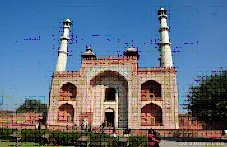 SIKANDRA – This beautifully maintained monument is where EMPEROR AKBAR was buried. It is a very low profile monument but it has one of the most awe – inspiring tombs. It is surreal how one of the greatest emperors has been put to rest. The manicured lawns has spotted and other varieties of deer roaming in them. Named after the Afghan ruler Sikander Lodi, Sikandra is the final resting place of Emperor Akbar. The Emperor began the construction of his own garden mausoleum during his lifetime. However, the construction was completed by his son Jahangir in 1613. An impressive marble - inlaid gateway leads to the spacious four - tiered monument which is crowned by a white marble cenotaph and screen. What is interesting is that the structure imbibes the best of Hindu, Christian, Islamic, Buddhist, Jain motifs, signifying the new religion started by Akbar – the DEEN E ILAHI.
SIKANDRA – This beautifully maintained monument is where EMPEROR AKBAR was buried. It is a very low profile monument but it has one of the most awe – inspiring tombs. It is surreal how one of the greatest emperors has been put to rest. The manicured lawns has spotted and other varieties of deer roaming in them. Named after the Afghan ruler Sikander Lodi, Sikandra is the final resting place of Emperor Akbar. The Emperor began the construction of his own garden mausoleum during his lifetime. However, the construction was completed by his son Jahangir in 1613. An impressive marble - inlaid gateway leads to the spacious four - tiered monument which is crowned by a white marble cenotaph and screen. What is interesting is that the structure imbibes the best of Hindu, Christian, Islamic, Buddhist, Jain motifs, signifying the new religion started by Akbar – the DEEN E ILAHI.
Evening enjoy the Kalakriti – Theatre presentation of the story of TAJ MAHAL.
Overnight will be at Agra.
Enjoy breakfast at the hotel.
Proceed for day sightseeing of Agra. TAJ MAHAL: Little needs to be said about this architectural wonder which is always the soul raison-de-etre for every tourist's visit to Agra. Built by Shah Jahan, the Taj is a white marble memorial to his beautiful wife Mumtaz Mahal. This monument took 22 years to be completed and was designed, and planned by Persian architect Ustad Isa. Apart from its stunning design balance and perfect symmetry, the Taj is also noted particularly for its elegant domes, intricately carved screens and some of the best inlay work ever seen.
TAJ MAHAL: Little needs to be said about this architectural wonder which is always the soul raison-de-etre for every tourist's visit to Agra. Built by Shah Jahan, the Taj is a white marble memorial to his beautiful wife Mumtaz Mahal. This monument took 22 years to be completed and was designed, and planned by Persian architect Ustad Isa. Apart from its stunning design balance and perfect symmetry, the Taj is also noted particularly for its elegant domes, intricately carved screens and some of the best inlay work ever seen.
Horse cart ride to Taj Mahal.
AGRA FORT - Built by the famed Mughal emperor Akbar in 1565 AD, the fort is predominantly of red sandstone. Ensconced within is the picture perfect Pearl Mosque, which is a major tourist attraction. It lies on the bend of the river Yamuna, almost in the heart of the town. Akbar built it as his citadel over the years 1563-73 in the finest architectural style. It has imposing gates and walls of red sandstone and a moat.
After Agra Fort we will visit BABY TAJ – The interiors of which are considered better than the Taj.
Evening enjoy the walk in the MEHTAB BAGH (Mughal Garden) to enjoy the sunset view of TAJ MAHAL.
Overnight stay will be at hotel.
Enjoy breakfast at the hotel. Proceed to Ranthambhore en-route visit Fatehpur Sikri.
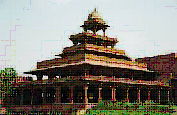 Fatehpur Sikri is 37 km west of Agra. JALAL – UD – DIN – MUHAMMAD AKBAR named Akbar, Humanyun's son, accessed the throne at the tender age of 14. While hunting around Sikri his curiosity was aroused by the songs of some minstrels about the celebrated Khwaja -Mu'inu'd-din Chisti, the founder of the Chisti order of SUFIS. Akbar, who was without a male heir heard about Saint Salim Chisti and visited him in the year 1568. The saint blessed him with 3 sons and in gratitude Akbar ordered the great mosque of Fatehpur Sikri built under his supervision. As a mark of respect to the saint, Akbar shifted his capital to Fatehpur Sikri and built various secular buildings like the Diwan -I-Am, Diwan-I-Khas, Jodhabai palace, Birbal's house, Marian's house and the Panchmahal.
Fatehpur Sikri is 37 km west of Agra. JALAL – UD – DIN – MUHAMMAD AKBAR named Akbar, Humanyun's son, accessed the throne at the tender age of 14. While hunting around Sikri his curiosity was aroused by the songs of some minstrels about the celebrated Khwaja -Mu'inu'd-din Chisti, the founder of the Chisti order of SUFIS. Akbar, who was without a male heir heard about Saint Salim Chisti and visited him in the year 1568. The saint blessed him with 3 sons and in gratitude Akbar ordered the great mosque of Fatehpur Sikri built under his supervision. As a mark of respect to the saint, Akbar shifted his capital to Fatehpur Sikri and built various secular buildings like the Diwan -I-Am, Diwan-I-Khas, Jodhabai palace, Birbal's house, Marian's house and the Panchmahal.
Proceed to Ranathmbhore.
Ranthambhore Tiger Reserve, at the junction of the Aravalis and the Vindhyas, is a unique example of natural and historical richness, standing out conspicuously in the vast, arid and denuded tract of eastern Rajasthan, barely 14 kilometers from Sawai Madhopur. Get in tune with nature for a luxury holiday in the heart of the jungle. Most of the resorts are close to the National Park Gate, Tiger Den being the closest.
It spreads over a highly undulating topography varying from gentle to steep slopes; from flat topped hills of the Vindhyas to the conical hillocks and sharp ridges of the Aravalis, from wide and flat valleys to narrow rocky gorges. An important geological feature the ‘Great Boundary Fault’ where the Vindhya plateaus meet the Aravali Hill range meanders through the Reserve. The National Park is bound by the rivers Chambal in the south and Banas in the north.
Tiger, at the apex of the food chain, lord over the kingdom in a subtle way. Solitary by nature, it operates in stealth. Therefore tiger sightings, frequent as they are, are always a matter of chance. However, even evidences of tiger's activities are very exciting.
Overnight will be at Hotel.
 Wake up early morning and leave for your safari into the National Park. Track the tigers and other wildlife through the morning. Return to the resort / lodge by 1000 in the morning and have breakfast.
Wake up early morning and leave for your safari into the National Park. Track the tigers and other wildlife through the morning. Return to the resort / lodge by 1000 in the morning and have breakfast.
Freshen up and either spend time at the pool or visit the town. You could also go for a nice visit to the temple on top of the fort.
In the afternoon have lunch and then leave again for you afternoon safari. The safari will be till evening 1700 – 1800 hr and then return to the resort / lodge.
There are good numbers of Asian Elephants, crocodile, Wild Boar, Water Buffalo and Grey langurs amongst other large animals.
Dinner will be at the resort and retire early for the night. Overnight will be at Ranthambhore.
Overnight will be at AGRA.
Breakfast will be at Hotel. Proceed to Jaipur and on arrival check in at hotel.
JAIPUR - The origins of the beautiful city of Jaipur can be traced back to the eighteenth century, during the reign of Jai Singh II who ascended the Amber throne in 1699. Jaipur today, epitomizes the spirit of Rajputana. In-spite of growing into a bustling metropolis, it still retains its character and history - A beautiful fusion of the yesteryears and modernity. It is popularly known as the Pink City because of the extensive use of the locally abundant pink plastered stone, painted so in honor of the visit of the royal consort of Queen Victoria. Jaipur thrills the soul with its massive forts, magnificent palaces, exquisite temples and lush gardens.
 This evening, visit the Birla Temple to learn more about the fascinating religious life of Jaipur. The marble structure, built as recently as 1985, houses ornate statues including one of Lakshmi (goddess of Wealth and Beauty) and Narayan dressed in gaudy robes, representing a Hindu vision of heavenly luxury. Carvings in the temple and on pillars supporting the covered walkways include images of the Hindu pantheon, as well as Jesus, the Blessed Virgin Mary and St Francis of Assisi. Your visit will coincide with the AARTI Ceremony, which involves oil lamps being lit and waved, in order to awake and invoke the deity. Enjoy the experience and spend night at Jaipur.
This evening, visit the Birla Temple to learn more about the fascinating religious life of Jaipur. The marble structure, built as recently as 1985, houses ornate statues including one of Lakshmi (goddess of Wealth and Beauty) and Narayan dressed in gaudy robes, representing a Hindu vision of heavenly luxury. Carvings in the temple and on pillars supporting the covered walkways include images of the Hindu pantheon, as well as Jesus, the Blessed Virgin Mary and St Francis of Assisi. Your visit will coincide with the AARTI Ceremony, which involves oil lamps being lit and waved, in order to awake and invoke the deity. Enjoy the experience and spend night at Jaipur.
Overnight will be in Jaipur.
Breakfast will be at hotel. Proceed for a morning excursion will be taken to the Amber Fort. Enjoy the fort ascent on elephant back in a royal manner.
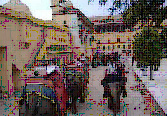 AMBER FORT PALACE - Amber is the classic romantic Rajasthani fort palace. Its construction was started by Man Singh I in 1592, and completed by his descendent Jai Singh I. Its forbidding exterior belies an inner paradise where a beautiful fusion of Mughal and Hindu styles finds its ultimate expression.
AMBER FORT PALACE - Amber is the classic romantic Rajasthani fort palace. Its construction was started by Man Singh I in 1592, and completed by his descendent Jai Singh I. Its forbidding exterior belies an inner paradise where a beautiful fusion of Mughal and Hindu styles finds its ultimate expression.
Afternoon sightseeing tour of Jaipur visiting...
CITY PALACE - A delightful blend of Mughal and traditional Rajasthani architecture, the City Palace sprawls over one-seventh of the area in the walled city. It houses the Chandra Mahal, Shri Govind Dev Temple and the City Palace Museum.
JANTAR MANTAR - This is the largest and the best preserved of the five observatories built by Jai Singh II in different parts of the country. This observatory consisting of outsized astronomical instruments is still in use.
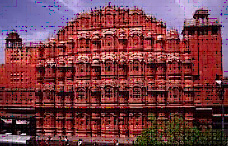 HAWA MAHAL - The ornamental facade of this "Palace of Winds" is a prominent landmark in Jaipur. It is a five-storey structure of sandstone plastered pink encrusted with fine trelliswork and elaborate balconies. The palace has 953 niches and windows. Built in 1799 by Pratap Singh, the Mahal was a royal grandstand for the palace women.
HAWA MAHAL - The ornamental facade of this "Palace of Winds" is a prominent landmark in Jaipur. It is a five-storey structure of sandstone plastered pink encrusted with fine trelliswork and elaborate balconies. The palace has 953 niches and windows. Built in 1799 by Pratap Singh, the Mahal was a royal grandstand for the palace women.
Enjoy the Light and Sound show in the evening at the fort.
Overnight will be at Jaipur.
Breakfast will be at Hotel.
Proceed to Jodhpur. Reach and check in at Hotel.
Set at the edge of the THAR Desert, the imperial city of Jodhpur echoes with tales of antiquity in the emptiness of the desert. Once the capital of the Marwar state, it was founded in 1459 AD by Rao Jodha-chief of the RATHORE clan of Rajputs who claimed to be descendants of Rama - the epic hero of the RAMAYANA. It is also referred as the Blue City, due to the indigo tinge of the whitewashed houses around the Mehrangarh Fort (the old city). The blue houses were originally for Brahmins but non-Brahmins soon joined in, as the colour was said to deflect the heat and keep mosquitoes away. Jodhpur lies near the geographic center of Rajasthan state, which makes it a convenient base for travel in a region much frequented by tourists. The old city of Jodhpur is surrounded by a thick stone wall. The wall has six huge gates called Nagauri gate, Merati gate, Sojati gate, Jalori gate, Siwanchi gate and Chand pol.
Drive to the BISHNOI VILLAGES for a short jeep safari.
Visit the BISHNOI VILLAGES and have a rare glimpse into the rich culture and true essence of India. This village is inhabited by the Bishnoi community. They are staunch believers in the sanctity of plant and animal life. Villages are marked by Khejri trees and deer which thrive. Memorable moments of the great desert landscape fascinates one while driving along the countryside.
Overnight will be at Jodhpur.
Breakfast will be at Hotel.
Enjoy the sightseeing tour of the city.
Mehrangarh Fort - Situated on a steep hill, Mehrangarh fort is one of the largest forts in India. The beauty and the grandeur of numerous palaces in the fort narrates a saga of hard sandstones yielding to the chisels of skilled Jodhpuri sculptures. Mehrangarh Fort, spreading over 5 km on a perpendicular hill and looking down 125 meters, presents a majestic view on city horizon. It was built on advice of a saint in 1459 to establish an impregnable head-quarter. This Fort is one of the best in India with its exquisitely latticed windows, carved panels, elaborately adorned windows and walls of Moti Mahal, Phool Mahal, Sheesh Mahal. A collection of musical instruments, palanquins, royal costumes, furniture and the cannons on the fort's ramparts are well preserved.
Jaswant Thada - Close to the fort complex, lies Jaswant Thada. This 19th century royal cenotaph built in white marble in commemoration of Maharaja Jaswant Singh II and three other cenotaphs, stand nearby. The cenotaph of Maharaja Jaswant Singh holds the rare portraits of the rulers and Maharajas of Jodhpur. A visit inside the cenotaphs, with some villagers of the region, would bring forward the reverence they still hold for their brave kings.
 Umaid Bhawan Palace: The romantic looking Umaid Bhawan Palace was actually built with the purpose of giving employment to the people of Jodhpur during a long drawn famine. The royal family of Jodhpur still lives in a part of the palace.Another part of the palace houses a well-maintained museum, displaying an amazing array of items belonging to the Maharaja and the royal family - weapons, antiques & fascinating clocks, crockery and trophies.
Umaid Bhawan Palace: The romantic looking Umaid Bhawan Palace was actually built with the purpose of giving employment to the people of Jodhpur during a long drawn famine. The royal family of Jodhpur still lives in a part of the palace.Another part of the palace houses a well-maintained museum, displaying an amazing array of items belonging to the Maharaja and the royal family - weapons, antiques & fascinating clocks, crockery and trophies.
Proceed to Udaipur en-route visit RANKAPUR TEMPLES.
The RANAKPUR TEMPLES, dating back to the 15th century have 200 pillars, none of which are alike, support its 29 halls. The Temple abounds with intricate friezes and sculptures. Includes visits to two more Jain temples and the Temple of the Sun God with its erotic sculptures.
Reach Udaipur and relax.
The city of Dawn, Udaipur is a lovely land around the azure lake, hemmed in by the lush hills of the ARAVALLIS. A vision in white drenched in romance and beauty, Udaipur is a fascinating blend of sights, sound and experiences and inspiration for the imagination of poets, painters and writers.
Its kaleidoscope of fairy-tale palaces, lakes, temples, gardens and narrow lanes strewn with stalls, carry the flavor of a heroic past, epitomizing valor and chivalry. Their reflection in the placid waters of the LAKE PICHOLA is an enticing sight. Udaipur is the jewel of MEWAR -a kingdom ruled by the Sisodia dynasty for 1200 Years.
Proceed for Evening Motor launch cruise on the placid waters of Lake Pichola. From the boat you will be able to view the city of Udaipur as it rises majestically above the lake in the middle of the Rajasthan desert. Also visit the Jag Mandir Palace - the other island palace in the middle of the lake. Spend some time at the Jag Mandir Palace.
Overnight will be at Udaipur.
Breakfast will be at hotel.
Proceed for sightseeing tour of Udaipur, stopping first at City Palace.
City Palace - Standing on the east bank of lake Pichola, is a massive series of palaces built at different times from 1559 A.D. The balconies of the palace provide panoramic views of "Jag Niwas" (the world wide famous Lake palace hotel), Jag Mandir on one side and on the other the city of Udaipur. Its main entrance is through the triple-arched gate - the Tripolia, built in 1725. The way now leads to a series of courtyards, overlapping parations, terraces, corridors and gardens - a harmonic profusion hard to describe. There is a Suraj Gokhda, where the maharanas of Mewar presented themselves in the times of trouble to the people to restore confidence. The Mor-chowk (Peacock courtyard), gets its name from the vivid mosaics in glass decorating its walls. The chini chitrashala is noteworthy while a series of wall paintings of KRISHNA are on display in Bhim Vilas. There are numerous other palaces such as Dilkhush mahal, Sheesh mahal, Moti mahal and Krishna vilas - in memory of a princess of striking beauty who poisoned herself to avert a bloody battle for her hand by rival princess. Now the palace contains many antique articles, paintings, decorative furniture and utensils and attracts thousands of visitors every day.
Here you will marvel at rooms with mirrored walls and ivory doors, colored glass windows and inlaid marble balconies and the Peacock Courtyard.
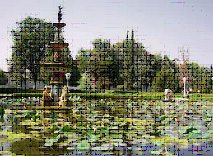 Saheliyon ki Bari -Maharana Sangram singh builds this in the mid 18th century. The 'garden of the maidens' brings to mind the lifestyle of the ladies of the court. The delightful gardens appear discreet and in impeccable taste. There are four pools with dainty kiosks, and all around are flowerbeds, lawns, pools and fountains protected by a series of walls and shady trees. The Foundation of the Sahelion ki bari functions solely by water pressure and no pumps are used. The garden has a lotus pool, a sitting room decorated with paintings and glass mosaics. The whole ambiences is flavored by the nostalgia of those beautiful bells enjoying themselves in a lavish aura.
Saheliyon ki Bari -Maharana Sangram singh builds this in the mid 18th century. The 'garden of the maidens' brings to mind the lifestyle of the ladies of the court. The delightful gardens appear discreet and in impeccable taste. There are four pools with dainty kiosks, and all around are flowerbeds, lawns, pools and fountains protected by a series of walls and shady trees. The Foundation of the Sahelion ki bari functions solely by water pressure and no pumps are used. The garden has a lotus pool, a sitting room decorated with paintings and glass mosaics. The whole ambiences is flavored by the nostalgia of those beautiful bells enjoying themselves in a lavish aura.
Bagore ki Haveli -This is a very congenial old building built right on the waterfront of Lake Pichola at Gangori Ghat. Amir Chand Badwa, the Prime Minister of Mewar built it in the eighteenth century. The palace has over hundred rooms and some very interesting display of costumes and modern art. The glass and mirror in the interiors of the Haveli delicate work and well preserved too. It also preserves a fine example of Mewar Painting on the walls of Queen's Chamber. The two peacocks made from small pieces of colored glasses are fine examples of glasswork. After the death Badwa the building became the property of Mewar State. It came to be occupied by Maharana Shakti Singh of Bagore who built the palace of the three arches also in 1878 and it acquired its name of Bagore-ki-haveli, the house of Bagore. After independence the structure lay in neglect until 1986 when it housed the West Zone Cultural centre.
Jagdish Temple -The temple is situated in the middle of the city. The temple of Jagannath Rai, now called Jagdish-ji, is a major monument and should be seen carefully. Raised on a tall terrace and completed in 1651, it is a tribute alike to the tenacity of its builders and the resilence of the art tradition it represents. It attaches a double storeyed Mandapa (hall) to a double - storied, saandhara (that having a covered ambulatory) sanctum. The mandapa has another storey tucked within its pyramidal samavarna (bell - roof) while the hollow clustered spire over the sanctum contains two more, non - functional stories. Lanes taking off from many of the sheharpanah (city wall) converge on the Jagdish Temple and walking leisurely through them brings you face with the many layers of the cultural palimpsest that Udaipur is. It was built by Maharana Jagat Singh Ist in 1651 A.D.
Evening visit Crystal Gallery to visit MAHARAJA’s Private collections.
Overnight will be in Jaipur.
Breakfast will be at hotel. Relax in the morning. Proceed to the airport for flight to Delhi. Reach and enjoy the last minute shopping.
Proceed to the airport as per flight timing and enjoy the FAREWELL DINNER. Board the flight for home with sweet memories of India.
TOUR ENDS